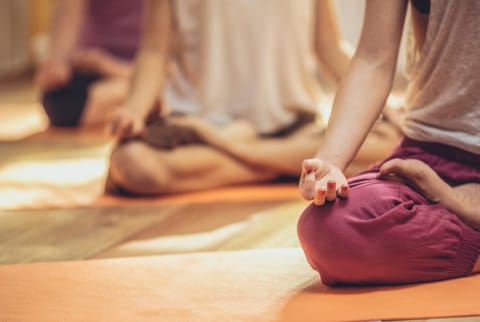Advertisement


The popularity of meditation is a wonderful thing. What could be better than a more peaceful and mindful planet!? But there's also a lot of confusion going around about how to practice. In response to some of the most common questions I'm asked about meditation, I've created this list of tips for anyone looking to get started.
1. Make it a formal practice.
We hear a lot about living more mindfully, and it’s true that we benefit from bringing more awareness to our daily activities but if you want to experience the real benefits of meditation, then you’ll also need to set aside a specific time to practice in stillness every single day.
2. Start with the breath.
The breath is the intersection point for the mind and body. Breathing deeply and fully slows the heart rate, activates the parasympathetic nervous system and invites your mind to relax.
Give yourself a few minutes to transition from what you were doing before closing your eyes. If you’re finding it difficult to sit down and meditate, start slowing things down 15 minutes before you begin. Become aware of your breath, body and mind. The breath is also a wonderful anchor or focus point for your meditation practice.
3. Find a teacher.
Meditation is ultimately a very personal journey but it’s incredibly helpful to have the guidance of a teacher, especially when you’re starting out. Read a book (or two) on meditation and research teachers and courses in your area.
4. Think of meditation as "becoming aware" rather than "turning off the mind."
We often hear that the purpose of meditation is to "quiet the mind," but it’s perhaps better understood as a way of entering into the quiet that is already resides there. Similarly, beginner meditators often think that the goal of meditation is to focus without become distracted. A more useful goal of the practice is actually becoming aware of when your mind has drifted, or aim to be able to redirect your attention back to your point of focus without criticizing yourself.
5. Do not expect your mind to be quiet.
One of the biggest (and most unhelpful) meditation myths is that when you meditate, you should try to stop all of your thoughts. This one is simply not true, according to traditional texts of meditation and even modern science.
The goal of meditation is not to stop all thinking, but to change your relationship to your thoughts so that you’re not so caught up in them and swept away by them. We now have myriad studies that demonstrate the healing power of meditation — that people are less affected by negative and unhelpful thinking — but it’s never been the case that thinking actually stops.
If you begin meditation with the aim of stopping all thoughts, then you’re going to be very disappointed. You’re also going to have a pretty unpleasant time in doing so and you’ll likely give up.
6. Be comfortable.
The most important rule as it relates to posture is to be comfortable. Don’t punish yourself with an unpleasant posture that simply doesn’t work for your body. Mind and body are intertwined. If your body is well-balanced, your mind will also be in balance.
7. Rest your attention effortlessly.
While it takes effort to create the time and space to meditate, your practice should be completely effortless. Let go of trying and striving and allow whatever is happening to do so with the least resistance. By gently resting your attention on your breath or mantra, your brain and mind will naturally drop into the more expansive state of meditative awareness.
8. Smile.
A gentle smile will enhance your practice, a furrowed brow will not. Turn up the corners of your mouth and smooth out your brow. If you find yourself drifting off or focusing too sternly on your meditation, gently loosen your neck and shoulders, reset your posture and smile once again.
9. Start small.
When you’re starting out, even just a few minutes can feel like an incredibly long time. Meditation is not an endurance test, set a reasonable time frame for you and diligently follow it. It’s also important to banish all-or-nothing thinking — if you’d like to meditate for 20 minutes, but you only have 10 minutes available, then dive in and enjoy those 10 minutes to their fullest. Don’t avoid your practice altogether because you don’t have the "ideal" time frame or environment.
10. Be realistic in your expectations.
Meditation is a technique for training the mind, and this skill is developed over a lifetime. Sure, there are some immediate benefits to be found, but some take longer than others. If expectations are too high, then you may well feel disappointed and demotivated, causing you to give up. So just take one day at a time and focus on building a slow and steady practice.